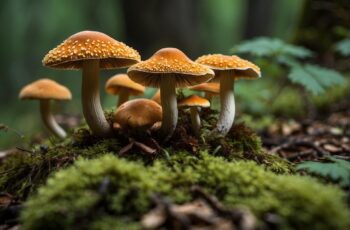Mushrooms are fascinating organisms, and when you delve into the world of tree mushrooms, you’ll discover a surprisingly diverse range of species that grow on trees. Also known as wood-decay fungi, these mushrooms play a crucial role in breaking down dead wood, recycling nutrients, and supporting other life in the ecosystem. In this article, we will explore some common tree mushrooms and their characteristics, focusing on their appearance, habitats, and uses.
As you embark on your journey through this fascinating realm, you’ll encounter various tree mushrooms such as Oyster Mushrooms, Lion’s Mane, and Birch Polypore, which have unique appearances and environmental preferences. Some of these mushrooms grow on living trees, while others prefer deadwood or decomposing stumps. Understanding the diversity of tree mushrooms and their growth patterns can help you appreciate the role they play in the natural world and potentially identify them on your hikes and nature walks.
In addition to appreciating the visual and ecological aspects of tree mushrooms, you might be intrigued by their culinary and medicinal uses. Several tree mushroom species are not only edible but also highly prized for their flavors and textures. Moreover, some of these fungi have been traditionally used for their potential health benefits. As you read on, we invite you to discover the fascinating world of tree mushrooms and the various ways in which they can enrich your understanding of nature and its interconnected wonders.
List of Common Tree Mushrooms in the US
Grifola Frondosa (Maitake Mushroom)
Maitake mushrooms, also known as Hen of the Woods or Ram’s Head, grow at the base of trees like oaks in the United States. They’re most commonly found in China, Japan, and northeastern North America. Their harvest season is from late summer to early autumn after rain. Maitake mushrooms help break down organic matter and are considered edible and tasty.
Laetiporus Sulphureus (Chicken of the Woods)
Chicken of the Woods mushrooms are bright orange-yellow shelf mushrooms, typically found on hardwood trees. They obtain nutrients by breaking down both white and brown rot in wood. These wild mushrooms are edible and have a taste and texture similar to chicken when cooked. Make sure to properly identify them before consuming, as there are some inedible look-alikes.
Hericium Erinaceus (Lion’s Mane Mushroom)
Lion’s Mane mushrooms grow on living tree trunks or deadwood in the United States, Europe, and Asia. These unique fungi are covered in soft, hair-like spines and are best known for their potential cognitive benefits. Lion’s Mane mushrooms are edible and taste like crab meat when cooked.
Armillaria (Honey Mushroom)
Honey mushrooms are a group of Armillaria species that grow on trees and decompose wood and organic matter. They are wild mushrooms and can be both edible and inedible, depending on the species. Make sure to properly identify these mushrooms before consuming them, as some species can be toxic.
Ganoderma (Reishi Mushroom)
Reishi mushrooms, also known as Ganoderma, are wood-decaying fungi that grow horizontally on tree trunks. They’re known for their medicinal properties, particularly in Chinese medicine. Reishi mushrooms are not consumed for their taste, but rather for their potential health benefits. The most common species in the United States is Ganoderma tsugae, which grows on conifer trees.
Trametes Versicolor (Turkey Tail Mushroom)
Turkey Tail mushrooms are colorful shelf mushrooms that grow on trees, particularly hardwoods, in the United States. They help decompose wood by breaking down white rot. These mushrooms are not considered edible, but they’re known for their medicinal properties, particularly in supporting the immune system. Turkey Tail mushrooms have a leathery texture and unique, fan-like shape.
As you explore the different types of mushrooms that grow on trees in the United States, be sure to research each species and properly identify them before consuming.
In Which States Do Tree Mushrooms Grow
Tree mushrooms are a diverse group of fungi that grow on trees in various states across the United States. In this section, we will discuss some of the common types of tree mushrooms and the states in which they are typically found.
Grifola Frondosa
Grifola frondosa, also known as maitake or hen of the woods, is a type of tree mushroom commonly found in eastern parts of the United States, particularly in the northeastern region. They grow at the base of oak trees and sometimes on other hardwoods. In your foraging expeditions, look for them in states like New York, Pennsylvania, and Virginia.
Laetiporus Sulphureus
Laetiporus sulphureus, or the chicken of the woods mushroom, can be found in many states across the United States, though it is most commonly observed in eastern and southern regions. This mushroom is often found on hardwood trees such as oaks, in states like Florida, Georgia, and North Carolina.
Hericium Erinaceus
Hericium erinaceus, or lion’s mane mushroom, is a tree-dwelling mushroom native to North America, Europe, and Asia. In the United States, you can find it growing on both living tree trunks and deadwood, throughout the country, with sightings reported in states like Oregon, California, and the northeastern states.
Armillaria
Armillaria, commonly known as honey mushrooms, is a group of fungi that grow on trees throughout the United States. These mushrooms can be found in a variety of states, including those in both the eastern and western regions of the country, like Ohio and Washington.
Ganoderma
Ganoderma refers to a group of mushrooms, such as the reishi mushroom, that can be found growing on trees across the United States. These mushrooms are often found on hardwood trees, such as oaks and maples, in states like California, Texas, and Florida.
Trametes Versicolor
Trametes versicolor, also known as turkey tail mushrooms, are commonly found on deadwood and stumps of hardwood trees throughout the United States. When searching for these mushrooms, you may spot them in both the eastern and western regions of the country, including states like New York and Oregon.
Edible Tree Mushrooms in the US
With an abundance of edible mushrooms in the US, this guide focuses on three popular varieties that grow on trees. These tree mushrooms are not only delicious but also offer unique flavors and textures.
Grifola Frondosa (Maitake)
Grifola frondosa, commonly known as Maitake, is a popular edible mushroom species in the US. It typically grows on the base of hardwood trees, especially oak trees, and is often found in clusters. The mushroom has a brownish-gray color and a distinctive overlapping pattern of its caps.
To prepare Maitake mushrooms, you can simply:
- Brush off any dirt or debris
- Cut the individual caps into bite-sized pieces
- Sautee, grill, or add them to your favorite dishes
Due to its umami-rich flavor, Maitake is a perfect addition to various dishes such as soups, stir-fries, and rice dishes.
Laetiporus Sulphureus (Chicken of the Woods)
Laetiporus sulphureus, or Chicken of the Woods, is another edible tree mushroom you can find in the US. The mushroom has an unmistakable vibrant orange-yellow color and can be found on various tree types like oak and beech.
Preparing Chicken of the Woods comes with ease:
- Thoroughly clean the mushroom to remove dirt
- Cut into smaller pieces
- Cook thoroughly in soups, stews, or simply sauted with garlic and herbs
Its unique chicken-like texture and mild flavor make it an excellent substitute for meat in many dishes.
Hericium Erinaceus (Lion’s Mane)
Hericium erinaceus, popularly known as Lion’s Mane, is a white, shaggy-looking mushroom that grows on hardwood trees. With a seafood-like taste and texture similar to crab or lobster, this mushroom is a sought-after edible variety.
To enjoy Lion’s Mane, follow these simple steps:
- Gently clean and remove any debris
- Slice it into desired portions
- Cook by sauteeing, grilling, or adding it to soups and pasta dishes
Lion’s Mane has a unique flavor profile that complements numerous dishes and enhances the overall eating experience.
Remember to always exercise caution and practice diligent identification techniques to ensure a safe foraging experience while searching for these edible tree mushrooms in the US.
Preventing and Managing Tree Mushroom Growth
Mulching
Mulching is an effective way to prevent tree mushroom growth. Apply a layer of mulch around your tree’s base, using organic materials like wood chips or bark. Mulch not only suppresses the growth of fungi but also helps in retaining moisture and moderating soil temperature, promoting your tree’s overall health.
Arborist Services
Consulting with a professional arborist is crucial for managing and preventing tree mushrooms. They can diagnose any fungal issues, recommend treatment plans to suppress tree fungi, and suggest ways to restore your tree’s health. Additionally, arborists can advise you about removing and replacing infected trees with fungi-resistant species.
Gardening Tools
Keeping your gardening tools clean plays a significant role in preventing the spread of fungi. When pruning or cutting branches and limbs, ensure your tools are sanitized between uses to avoid transferring fungal spores from one tree to another. Maintaining a clean garden area further helps in reducing the chances of mushroom growth.
Managing Powdery Mildew
To manage powdery mildew, you need to pay attention to your tree’s surroundings and basic care practices. Here are some important steps to follow:
- Prune branches to improve air circulation.
- Water your tree early in the day, so the foliage can dry out before nighttime.
- Avoid using excessive nitrogen fertilizers, as they encourage disease development.
Regular monitoring and proper tree care practices will help keep powdery mildew at bay.
Armillaria Root Rot
To prevent Armillaria root rot, it’s essential to keep your tree strong and healthy. Follow these tips:
- Avoid wounding tree roots while planting or cultivating.
- Maintain general tree health by providing proper irrigation, fertilization, and pruning.
- Monitor for symptoms of Armillaria root rot, like clusters of yellowish-brown mushrooms, and consult an arborist if you suspect an infection.
By carefully following these guidelines, you can protect your trees from mushroom growth and maintain a healthy, thriving landscape.


